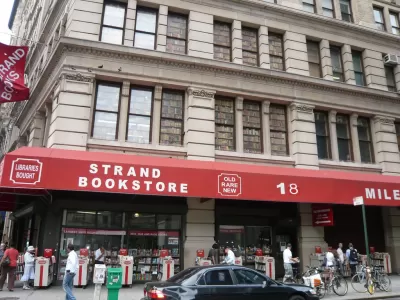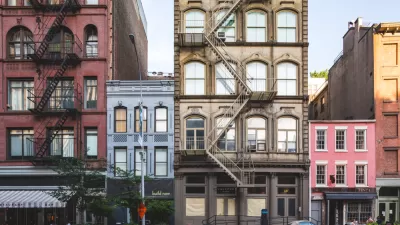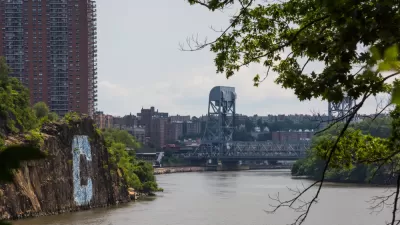The Renaissance Revival building that houses New York City's beloved Strand Bookstore is under consideration by the city's Landmarks Preservation Commission. The case has provoked debate between rival advocates.

"Since vacating 4th Avenue's legendary 'Book Row'—of which it is the only surviving store—in 1957, the Strand has blossomed into an adored cultural institution," Jack Denton writes. "Though colossal gentrification, the rise of Amazon, and various other bookseller-unfriendly forces have felled many other nearby stores, the Strand has remained."
Recently, a proposal from New York's Landmarks Preservation Commission to landmark the exterior of the Strand's building has provoked pushback. "Landmarking will limit the store's ability to make renovations, creating bureaucratic costs for the store's continued existence, the Strand and its supporters argue."
"In some ways, the owner of a for-profit business—albeit a culturally beloved one—fighting the city's proposed regulations on its building is a dog-bites-man story. However, the Strand's story also reflects a growing anti-landmarking coalition that views preservation initiatives as potentially harmful to the historic and culturally significant neighborhoods and buildings they intend to preserve."
Denton goes on to discuss the many angles from which advocates approach the desirability of landmarking. YIMBYs, for instance, oppose what they view as an imposition to new construction. Some anti-gentrification advocates dislike the practice because it can lead to higher perceived neighborhood desirability. Others see it as a way to fight rampant redevelopment. "In New York, landmarking of neighborhoods tends to raise housing costs in the outer boroughs, but not in already dense and expensive Manhattan, where the effect of landmarking on housing prices is small," Denton writes.
While some advocates suggest "pairing historic preservation initiatives with plans for adding affordable housing or easing zoning restrictions outside the landmarked district," to do so "would require the cooperation of multiple independent city agencies that may not be in communication—and which might have rival priorities."
FULL STORY: Is Landmarking a Tool of Gentrification or a Bulwark Against It?

Alabama: Trump Terminates Settlements for Black Communities Harmed By Raw Sewage
Trump deemed the landmark civil rights agreement “illegal DEI and environmental justice policy.”

Planetizen Federal Action Tracker
A weekly monitor of how Trump’s orders and actions are impacting planners and planning in America.

Why Should We Subsidize Public Transportation?
Many public transit agencies face financial stress due to rising costs, declining fare revenue, and declining subsidies. Transit advocates must provide a strong business case for increasing public transit funding.

Understanding Road Diets
An explainer from Momentum highlights the advantages of reducing vehicle lanes in favor of more bike, transit, and pedestrian infrastructure.

New California Law Regulates Warehouse Pollution
A new law tightens building and emissions regulations for large distribution warehouses to mitigate air pollution and traffic in surrounding communities.

Phoenix Announces Opening Date for Light Rail Extension
The South Central extension will connect South Phoenix to downtown and other major hubs starting on June 7.
Urban Design for Planners 1: Software Tools
This six-course series explores essential urban design concepts using open source software and equips planners with the tools they need to participate fully in the urban design process.
Planning for Universal Design
Learn the tools for implementing Universal Design in planning regulations.
Caltrans
Smith Gee Studio
Institute for Housing and Urban Development Studies (IHS)
City of Grandview
Harvard GSD Executive Education
Toledo-Lucas County Plan Commissions
Salt Lake City
NYU Wagner Graduate School of Public Service




























